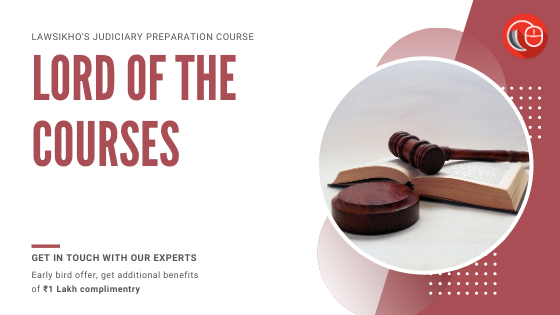This article is written by Anushka Singhal, a student of Symbiosis Law School, Noida. In this article, she throws some light on the issue of copy-paste judgments. She pens down some case laws and explains the ethics behind such copy-pasting.
Table of Contents
Introduction
‘Judgments of the Courts are the driving force of a country’. The judgments given by the Courts play an indispensable role in law-making in a common-law country. The principle of ‘Stare Decisis’ is followed here and the decisions of the Supreme Court are binding on all lower courts. The full form of the principle is “Stare decisis et non quieta movere”, which means, “stand by decisions and do not move that which is quiet”. Article 141 of the Indian Constitution lays down that the judgments of the Supreme Court are binding on all. The judges cite a previous judgment while writing their judgment. In the present times, apart from this, there has grown a new trend among the judiciary. Some Courts cut-copy-paste the decision of the lower court or tribunal when some case comes to them for appeal. Judicial plagiarism is rising today. Let us delve more into this issue and understand what is a copy-paste judgment and what are the issues associated with it.
Meaning of a copy-paste judgment
Almost everyone is familiar with the function of the shortcut keys Ctrl+C and Ctrl+V in a computer system. Ctrl+C is used to copy a text and Ctrl+V is used to paste the same. With the advent of technology, it has become very easy to copy-paste anything. This has led to an increase in copy-paste judgments. A copy-paste judgment is the one that is either copied from a previous judgment or is plagiarized from some source without giving due credit to the source. In such judgments, the judiciary does not apply their own ‘legal and logical reasoning’ and end up cut-copying and pasting. A judgment without reasoning is like a garden without flowers. In the case of Sec. & Curator Victoria Memorial v. Howrah Ganatantrik Nagrik Samity (2010), the Hon’ble Supreme Court held that “the hallmark of an order and exercise of judicial power by a judicial forum is to disclose its reasons”. Copy and paste judgments contravene this as they lack proper reasoning.
Cases on cut-copy judgments
There have been a plethora of cases that pointed towards the culture of cut-copy and paste in the Indian Judiciary. Let us discuss a few of them.
Union Public Service Commission v. Bhibu Prasad Sarangi and Ors. (2021)
This was a case regarding the promotion of IAS following vacancies. This judgment brought forward the issue of copy-paste judgments to the forefront. In this case, the appellant moved the High Court under Article 226 of the Constitution, challenging the order of the Central Administrative Tribunal of Cuttack. The case went further to the Supreme Court. The High Court had copied certain text from the tribunal’s judgment while holding that the decision of the tribunal was correct. While considering the appeal, the Supreme Court observed that the tendency of cut-copying and pasting has increased with the advent of technology. The Hon’ble Supreme Court held that the Courts should not think of increasing the volume of the judgment. The ‘quality’ matters and not the ‘quantity’. Judicial reasoning should be applied while penning down decisions. It has led us to ponder over this issue with much more seriousness.
P. Chidambaram v. Directorate of Enforcement (2019)
This case came into the limelight when P. Chidambaram’s son Karti Chidambaram posted a newspaper clipping with the title, ‘Cut, copy and paste’. This post led to hustle in the whole country. The case was on granting bail to P. Chidambaram and it was alleged that Justice Suresh Kumar Kait of the Delhi High Court has reproduced some paragraphs from a 2017 bail judgment. There was a stark similarity between the facts as well as the conclusion of both the judgments. Usually, there is a practice among judges and lawyers to refer to the facts of a case but it was in this judgment that verbatim was copied. The Court took suo-moto cognizance of the case and clarified that there was no cut, copy and paste as alleged by the newspaper and asked the newspaper to clarify the content of its article.
D.K Shivakumar v. Directorate of Enforcement (2019)
The copy-paste in this judgment was called a ‘tragic incident’ by Justice Rohinton Nariman. It was alleged that the Directorate of Enforcement (ED) had just copied the paragraphs from the plea that it had filed earlier in the case of P Chidambaram. On one of the pages of the plea, Mr Shivkumar was referred to as the ‘former finance minister’. It was a great blunder on the part of the ED. The Supreme Court rejected the bail application and the case again brought the issue of cut-copy and paste in the judicial system.
F. Hoffmann-La Roche Ltd. v. Cipla Ltd. (2012)
In this case, the judges fell into the trap of judicial plagiarism by citing an article in its judgment without acknowledging the author. The cut-copy-paste in this judgment came to the limelight when the authors of the article, Mr Eshan Ghosh and Ms Shwetashree Majumdar, wrote on Facebook that the para 4 to 37 of this article were copied from their article in the Queen Mary Journal of Intellectual Property. This was a severe allegation and the Delhi High Court was quick in taking the suo-moto cognizance of the case. It offered an apology and said that one of its interns has done this plagiarism. The Court had asked him to make the judgment concise and then it had incorporated the intern’s work while submitting its judgment.
Judicial plagiarism in foreign jurisdictions
This phenomenon is not only common in India but jurisdictions other than India have borne the brunt of this Ctrl+C and Ctrl+V. Cojocaru v. British Columbia Women’s Hospital and Health Centre (2013) was one such case of the Canadian Jurisdiction. The copying was condemned in this case but it was not found as a ground for declaring the judgment void. Let us discuss this case in depth.
Cojocaru v. British Columbia Women’s Hospital and Health Centre (2013)
This was a case of medical negligence. A lady was brought to the hospital for delivery. During the delivery, the woman suffered a uterus rupture due to which the oxygen supply to her child’s brain was interrupted and the child was born with certain deformities and was also a patient of cerebral palsy. The Trial Court awarded an amount of $4 million to the plaintiff while penning down a 368 para judgment. It was found that 321 paragraphs of the 368 paragraphs judgment were copied. The case was challenged and the Court of Appeal reversed the decision. It said that as the judgment was not based on the original analysis of the judge, it cannot be accepted. The case further went to the Supreme Court which held that though the judgment was copied, the plagiarism cannot hold as the sole ground for declaring a judgment as void. The Supreme Court held that the copying does not cast clouds of doubt on the impartiality of the judges. The judges have a lot of workloads and thus this practice can assist them in dealing with cases of the same kind.
Are the judges prohibited from copying and pasting?
The judges are not per se prohibited from citing lines and quotes from judgments, literary and research work. They must ensure that they acknowledge that they have taken this particular sentence from some source. Such copy and paste with acknowledgement in the form of footnotes, endnotes or any other referencing method would not infringe the provisions of the Copyright Act, 1957. Section 52 of the Copyright Act lays down the instances wherein plagiarism would not be punished. For example, when an author’s piece of work is fairly dealt with in personal research, dramatics, reproduction of any literary, dramatical or musical work for a judicial proceeding, etc., it will not be considered a violation of the Copyrights Act. But when there is no acknowledgement or when lawyers and judges simply copy the facts or judgment of an already decided case, it goes against the ethical conduct.
Judicial ethics and the problem with copy-pasted judgments
Judicial writing is altogether a different genre of writing. Not everyone can write in the same way as a judge writes. Judges are held to a higher moral standard and the highest professional standards. A judge is expected to analyse the whole situation carefully and sum up all that has been stated by both sides with a proper conclusion. The judges of the Supreme Court have to be more cautious when it comes to copy-paste judgments. Their judgments act as a binding precedent and thus one mistake would lead to a lot of problems and cater to a lot of criticism. The importance of a judgment can be understood with the fact that we have three to four rules of legal interpretation. The judges can use the Literal rule, the Mischief rule, the Golden rule or the Purposive rule to interpret and then can arrive at a conclusion. In judicial plagiarism, one might not resort to such in-depth analysis and thus the purpose of ensuring justice may not be satisfied. The Supreme Court adopted a charter called the ‘Restatement of Values and Judicial Life’ in May 1997. The restatement was verified in 1999 and since then both the Supreme Court and High Court judges of the country work according to it. The very first point of the restatement states that “Justice must not merely be done but it must also be seen to be done. The behaviour and conduct of members of the higher judiciary must reaffirm the people’s faith in the impartiality of the judiciary. Accordingly, any act of a Judge of the Supreme Court or a High Court, whether in an official or personal capacity, which erodes the credibility of this perception has to be avoided.” Copying and pasting in judgments seem to violate this principle. People have faith in the judiciary and this copying and pasting go against that faith. Similarly, the Bangalore Principles of Judicial Conduct, 2002 also lay down the expected conduct of a judge. A judge should be impartial, competent, show due diligence and propriety in all his activities. Judicial plagiarism goes against the ethical codes laid down for the judges. Also, it can lead to ‘tragic comedies’ as happened in DK Shivakumar’s case.
Conclusion
Judgment writing is an art. The art looks beautiful when it is blessed with originality. The same should be applied to the judgments. Every judgment is unique and thus there should be no blatant copy and pasting. Such judgments show the lack of analysis on the part of the judge. Also, lawyers should not file the case of appeal just by copying and pasting the previous judgment. There have been judgments where the Courts beautifully quoted some lines from literary sources. These were not considered wrong as the author was acknowledged. Such statements added beauty to the judgment. For example, the judgment in the famous case of Navtej Singh Johar v. Union of India (2018) cited the famous lines of Johann Wolfgang Von Goethe, “I am what I am”. It was not plagiarism. Therefore judges should try to retain the originality and can blend it with creativity. Ctrl C+ and Ctrl+V is not a good option. No doubt we live in an age of technology but ‘technology’ should not replace ‘originality’. As rightly said by Justice DY Chandrachud, there should be an independent application of mind.
References
- https://www.thequint.com/news/law/chidambaram-bail-denial-order-copy-paste-delhi-hc#read-more#read-more
- https://www.downtoearth.org.in/blog/governance/when-judges-copy-62674
- https://www.barandbench.com/news/copy-paste-job-in-eds-plea-against-dk-shivakumar-a-tragic-comedy-justice-rohinton-nariman
- https://www.livelaw.in/top-stories/fed-up-of-seeing-cut-copy-paste-orders-of-high-Courtsjustice-chandrachud-170755
- https://www.legallyindia.com/the-bench-and-the-bar/after-intern-writes-judgment-delhi-hc-apologises-for-34-paragraph-copy-paste-plagiarism-20151211-6957
LawSikho has created a telegram group for exchanging legal knowledge, referrals, and various opportunities. You can click on this link and join:
 Serato DJ Crack 2025Serato DJ PRO Crack
Serato DJ Crack 2025Serato DJ PRO Crack











 Allow notifications
Allow notifications



